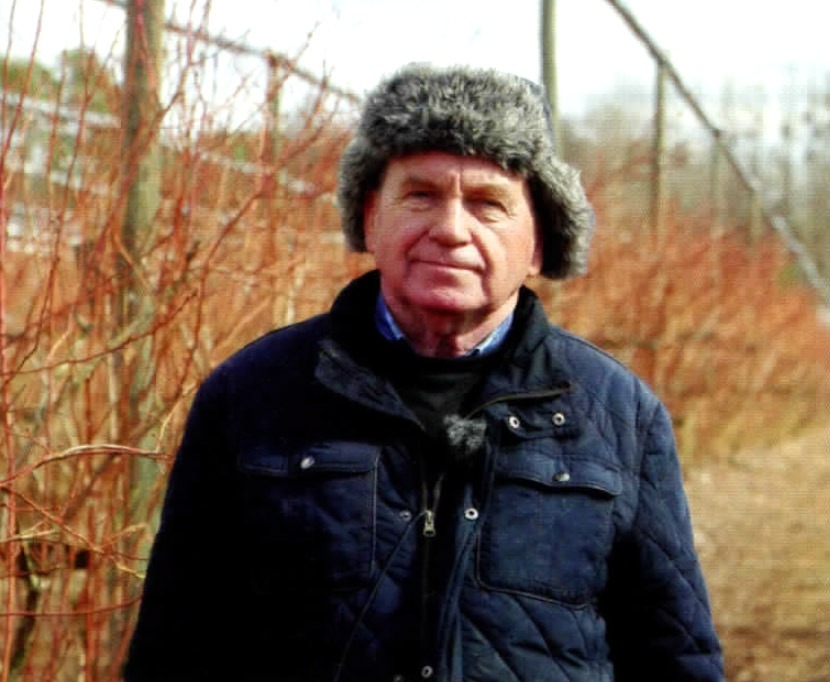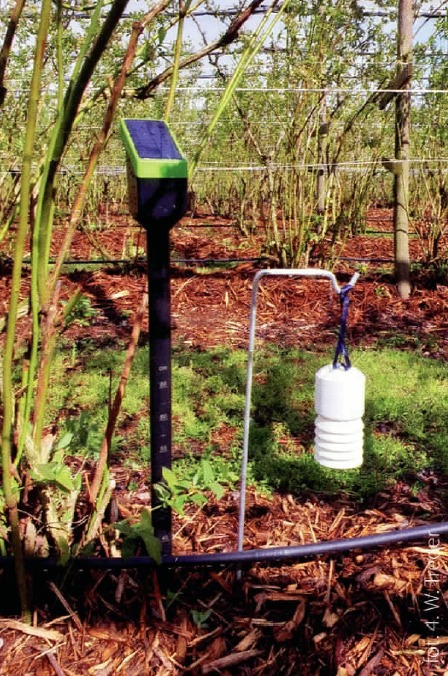Recent seasons show that nature is not always conducive to the production of the highest quality fruit. Frosts, droughts, and hailstorms always appear unexpectedly, but almost every time they cause unimaginable losses. However, the long tradition and experience gained in the production of blueberries on the Wilczewskis’ farm in Białousy (Podlasie) allowed them to develop appropriate strategies to fight against the adversities. The farm is currently equipped with 49 Orchard-Rite wind machines to fight frosts, as well as the modern AGREUS® system, which is responsible for the precise irrigation. Jerzy Wilczewski – the founder of the family farm (Photo 1), and his son Adam, talk about advanced technologies.

The Wilczewscy Family Horticulture Farm is currently one of the largest highbush blueberry plantations in Europe. It covers an area of approximately 600 hectares. The farm grows early blueberry varieties such as: ‘Duke’ and ‘Spartan’, the mid-early varieties: ‘Bluecrop’, ‘Bluegold’, ‘Calypso’, ‘Draper’, ‘Toro’ and Valor ‘, and the mid-late ones, which are ‘Chandler and ‘Lateblue’. They also cultivate the late ones as: ‘Last Call’ and ‘Liberty’. The varieties are selected in such a way as to ensure the continuity of the supply of fresh fruit for the longest possible period.
The weather was standing in the way of high quality
As Adam Wilczewski explains, in recent years the availability of labor has become more and more difficult. With such a large acreage, this may be a problem in the future. When it comes to exports (most of the production is sent to foreign markets), there is growing competition, but so far the high quality of the fruit produced on the farm is decisive.
On the road to high quality, however, there are some adversities from nature – these are primarily spring frosts, which, without appropriate countermeasures, would certainly cause huge losses, as well as cyclical problems related to the availability of water. Negative weather factors make us look for solutions that will not only help to fight adversities in the short term but will also determine the success of cultivation in the future.
We started our adventure with blueberry cultivation in 1992, it is a long time since then. We enjoyed growing these plants, but there were many adversities along the way. One of these torments were spring frosts and low winter temperatures – explains Jerzy Wilczewski, the founder of the farm in Białousy.
With high-temperature drops, not only the buds but also other parts of the shrubs froze. As explained by Mr. Jerzy, solutions that could limit losses caused by frosts have been searched for a long time. We tried the straw fog, but the results were average. We knew that a large water flow by anti-freeze system could be installed. But because our farm is located in Podlasie, and the nearest water source is about 7 km away, this solution could not be applied. Deep well drilling and water protection on some 600 hectares of the plantation were out of the question. I do not think that it could technically be successful, and besides, it would not be possible to obtain a permit for such water abstraction – he adds.
Krzysztof Zmarlicki from the Institute in Skierniewice gave me the information that the USA produces wind machines for protection against frost. I then went to the United States to buy a blueberry harvester and then I also contacted the windmill manufacturer – the Orchard-Rite company. The windmill works by drawing warm air from a height of about 70 meters. We decided to try – reports the grower.
Almost 20 years of experience
In the spring of 2002, the first windmill was delivered to the plantation in Białous, and it was set up in the place where spring frosts were most troublesome. It turned out that the machine does its job perfectly. The manufacturer’s specification said that one windmill raises the temperature on 7 hectares by about 7 °C. However, the hosts stated that there is no clear 7-hectare border and that the operation of the device goes further.
Our neighbor grew strawberries about 300 meters from the windmill. Part of the plantation was sheltered by a barn building. During the frost, the building blocked the flow of warm air from the windmill. The shielded strawberries were frozen, but the ones located in the open area were in good shape. This is probably the most tangible evidence for the operation of the machine – said J. Wilczewski.
The thermometers clearly show that shortly after starting the fan, the temperature rises by 2-3 °C in just 10-15 minutes. Later, the temperature rises at a slightly slower pace. The only disadvantage of the windmill is high fuel consumption. The device consumes approximately 40 liters of diesel fuel per hour.
The wind machine is a device consisting of a 12 meters height mast, an engine, and a propeller with a 6 meters diameter. It is worth adding that the propeller is inclined from the vertical by about 6 degrees. All parameters, such as the rotational speed and the diameter of the propeller, are selected so that the machine draws warmer air from a height of 50-70 meters and pushes it towards the ground. The blast of warm air towards the ground takes place every 4 minutes.
The temperature variation in individual locations is extremely large. The area of Podlasie, including the area of our farm, is quite hilly. Although it is hard to believe, at a distance of about 300 meters on a hill during frosts we can have +2 °C, and in the hole -5 ° or even -7 °. When the wind blows, the temperatures equalize, but in the case of windless weather we encounter situations as described – explains Mr. Jerzy.
The first windmill proved to be excellent in the fight against spring frosts, so in 2008 another 28 units were ordered.
This year, my sons and I decided to buy another 20 windmills. Currently, there are 49 windmills on our farm – he adds.
Windmills are used primarily in spring. There were also attempts to use them in winter when the temperature in 2010 dropped to -41 °C. The windmills at such a low temperature heated the plantation to -29 °C. However, since then they have not been used in winter, due to the relatively mild winters. This year, winter took its toll. During the first frost wave, -39 °C was recorded in the frost pool, but the windmills were not started.
The blueberry needs to be irrigated
A modern irrigation system plays an important role in the farm.
The last few seasons have been dry, with high air temperatures. In 2020, we had enough rainfall, which lulled our vigilance a bit, but it is not known how nature will surprise us in the years to come. Water resources are shrinking, hence the important role of precise irrigation – says Adam Wilczewski.
The Wilczewskis’ Farm has implemented one of the most modern monitoring system for soil humidity, temperature and salinity, measuring the climatic conditions – air temperature and humidity, dew point temperature and wet thermometer, as well as leaf moistening (photo 2). The AGREUS® system is the result of cooperation between Inventia and the Institute of Horticulture – National Research Institute in Skierniewice as part of the project “Development of an innovative system for measuring dispersed climate and soil parameters as a tool for optimizing irrigation, plant protection, and agrotechnical works”.

In the areas where the Wilczewskis’ farm is located, water resources are not the best, especially taking into account the cultivation acreage, responsible and precise water management becomes important from the beginning of the season. Therefore, only relying on reliable measurements of soil moisture allows you to control the situation and save water.
We only hydrate when it is needed. It happens very often that even though we think plants already need water, precise sensors tell us that it is not necessary yet. The result is not only water and energy savings but also a better condition of the plants. We also do not have to worry about the leaching of nutrients – says Adam Wilczewski.
Measurement probes with sensors are used to measure the humidity. Importantly, the number of sensors is unlimited. As many sensors as needed for a given plantation will be installed. The probe uses radio technology and regularly measures the moisture content in the soil profile. The second, very important components are stations that measure air temperature and humidity and use mathematical models to determine other parameters, such as the leaf wetness time. In the center, there is a base station connected to the network, which transmits data via radio to the cloud, where all measurements are collected (cloud-to-cloud). It connects to all components wirelessly using LoRa radio technology, so the sensor can be placed in any urban plantation. Each of the parameters determined by the sensors may have an alarm level set – the user defines the level which, if exceeded, should be notified by e-mail or SMS. It is a solution that can be used, for example, while monitoring spring frosts.
An irrigation controller powered by an alternating voltage of 24 V or 9 V, e.g. by a battery is the last element of the system. The controller opens and closes the valves depending on soil moisture or our individual decisions.
As Adam Wilczewski says, several systems have already been tested on the farm, but AGREUS® has worked best so far. Its unquestionable advantage is that it works remotely, we do not need wiring, and the measurement results can be monitored on an ongoing basis in the application on a tablet or smartphone. It aims to be able to control the work in the future from the level of a smartphone or tablet through an application, which will greatly facilitate the management of the farm. And although the farm pays a lot of attention to the tradition of the region, advanced technologies are now an inseparable element of modern plant production. Only thanks to them it is possible to carry out production at a high level with such success.
